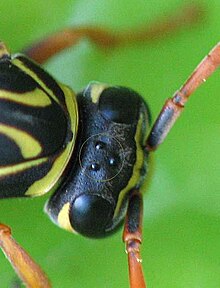
Back عين بسيطة Arabic Ocel (anatomia) Catalan Punktøje Danish Ocellus German Ojo simple Spanish چشم ساده در بیمهرگان Persian Pistesilmä Finnish Ocelle (œil) French Ollo simple Galician עינית (בעלי חיים) HE

A simple eye or ocellus (sometimes called a pigment pit[1][2]) is a form of eye or an optical arrangement which has a single lens without the sort of elaborate retina that occurs in most vertebrates. These eyes are called "simple" to distinguish them from "compound eyes", which have muliple lenses. They are not necessarily simple in the sense of being uncomplicated or basic.
The structure of an animal's eye is determined by the environment in which it lives, and the behavioural tasks it must fulfill to survive. Arthropods differ widely in the habitats in which they live, as well as their visual requirements for finding food or conspecifics, and avoiding predators. Consequently, an enormous variety of eye types are found in arthropods to overcome visual problems or limitations.
Use of the term simple eye is flexible, and must be interpreted in proper context; for example, the eyes of most large animals are camera eyes and are sometimes considered "simple" because a single lens collects and focuses an entire image onto the retina (analogous to a camera). By other criteria, the presence of a complex retina distinguishes the vertebrate camera eye from the simple stemma or ommatidia which make up compound eyes. Additionally, not all invertebrate ocelli and ommatidium have simple photoreceptors. Many have various forms of retinula (a retina-like cluster of photoreceptor cells), including the ommatidia of most insects and the central eyes of camel spiders. Jumping spiders and some other predatory spiders with seemingly simple eyes also emulate retinal vision in various ways. Many insects have unambiguously compound eyes consisting of multiple lenses (up to tens of thousands), but achieve an effect similar to that of a camera eye, in that each ommatidium lens focuses light onto a number of neighbouring retinulae.
- ^ "Catalog - Mendeley". www.mendeley.com. Archived from the original on 24 March 2012. Retrieved 4 May 2018.
- ^ O'Connor M, Nilsson DE, Garm A (March 2010). "Temporal properties of the lens eyes of the box jellyfish Tripedalia cystophora". J. Comp. Physiol. A. 196 (3): 213–20. doi:10.1007/s00359-010-0506-8. PMC 2825319. PMID 20131056.
© MMXXIII Rich X Search. We shall prevail. All rights reserved. Rich X Search